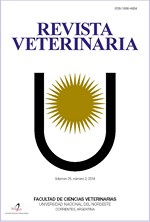Evaluation of growth of intact vs castrated Braford calves at different ages
DOI:
https://doi.org/10.30972/vet.3114630Keywords:
Calves, castration, growth, daily weigh, gainAbstract
We compared entire versus castrated male Braford calves, at different ages of castration, with the objective to evaluate this effect on growth by means of the total and daily weight gain. Twenty-eight Braford male suckling calves, were used. Animals were randomly divided into groups of 7 individuals: C45: castrated at 45 days of age; E45: entire, with 45 days of age; C90: castrated at 90 days of age and E90: entire, with 90 days of age. Individual weights were recorded on day 0 (castration’s day) and then on days 15, 30 and 45. Castration was performed by means of surgery. The studied variables were total gain (GT, kg of live weight) and average daily gain (GMD, kg/day). Descriptive statistics, analysis of variance (ANOVA) and Duncan’s test (p<0.05) were performed, considering as the main effect the age of castration (45 and 90 days), with the intact males as controls. The means for GT were: C45: 34.86 kg; E45: 37.29 kg; C90: 51.14 kg and E90: 44.29 kg. For GMD, they were: C45: 0.58 kg; E45: 0.62 kg; C90: 0.85 kg and E90: 0.74 kg. The ANOVA test showed significant differences for both variables, GT (p=0.0156) and GMD (p=0.0157), with C90 being the higher, considering the other groups. In particular, E90 group obtained intermediate values between C90 and calves of 45 days. Between C45 and E45, no significant differences were found for both variables. We conclude that a recommended castration time should be close to three months of age, since at 45 days of age live weight was more affected by the surgical technique.
Downloads
References
Arias R, Pérez FJ, Velásquez A, Alvarado AC. 2014. Ganancia de peso diaria de machos castrados vs. machos enteros durante la recría. Agro Sur 42: 23-29.
Bretschneider G. 2005. Effects of age and method of castration on performance and stress response of beef male cattle. Livest Sci 97: 89-100.
Bretschneider G. 2009. Castración de terneros: tradición versus eficiencia. Redvet 10: 3.
Carrillo J. 2017. Manejo de un rodeo de cría, 1° ed., 14° reimpresión, Ed. INTA, Buenos Aires, p. 194.
Council FAW. 1981. Advice to Agricultural Ministers of Great Britain on the need to control certain mutilations on farm animals, Ed. Middlesex, UK, p. 10.
Delaorden J, Demarco D. 2005. Efecto de la edad de castración en la ganancia diaria de peso hasta el destete en terneros al pie de madre. Rev Med Vet 86: 110.
Delcampo M. 2013. El bienestar animal aplicado a los sistemas de producción de ganado vacuno. I Simpósio Internacional sobre Sistemas de Produção de Bovinos de Corte, Fac.Agron.Univ.Fed.Rio Grande do Sul, Porto Alegre, Brasil, p. 132-163.
Dimarco O. 1998. Crecimiento de vacunos para carne, 1° ed., INIA, Mar del Plata, Argentina, p. 246.
Dirienzo JA et al. 2018. InfoStat versión 2018. Grupo InfoStat. FCA, Univ.Nac. de Córdoba, Argentina, http://www.infostat.com.ar.
Federation of Animal Science Societies (FASS). 2010. Guide for the care and use of agricultural animals in research and teaching, 3° Ed. Champlain, USA, p. 177.
Fubini S, Ducharme N. 2005. Cirugía en bovinos. En: Cirugía en animales de granja, 1° ed., Intermédica, Buenos Aires, Argentina, p. 133-478.
Garnero OJ, Perusia OR. 2002. Aparato reproductor del macho. En: Manual de anestesias y cirugías de bovinos, 2° ed., Imprenta San Cayetano, Esperanza (Santa Fe, Argentina), p. 76-91.
Ismail H. 2006. Effect of castration on feedlot performance, carcass characteristics and meat quality of Westren Sudan Baggara bulls. MSc Thesis, Faculty of Animal Production, University of Khartoum, Sudan, p. 117.
Micol D et al. 2009. Effect of age at castration on animal performance, muscle characteristics and meat quality traits in 26-month-old Charolais steers. Livest Sci. 120: 116-126.
Moreira FV et al. 2015. Effects of surgical castration, immunocastration and homeopathy on the performance, carcass characteristics and behaviour of feedlot-finished crossbred bulls. Sem Ciênc Agr 36: 1725-1734.
Rojas C. 1986. Efecto de tres niveles de suplementación invernal y tres edades de castración sobre la ganancia de peso y calidad de la canal en toritos Hereford. Agric Tecn Chile 46: 21-26.
Sampedro D, Calvi M. 2018. Caracterización de la ganadería vacuna del nordeste argentino. En: Cría vacuna en el NEA (Capitulo 1), Ed. INTA Ediciones, Corrientes, Argentina, p. 9-15.
Warnock T et al. 2012. Effect of castration technique on beef calf performance, feed efficiency, and inflammatory response. J Anim Sci 90: 2345-2352.
Downloads
Published
How to Cite
Issue
Section
License
Revista Veterinaria (Rev. Vet.) maintains a commitment to the policies of Open Access to scientific information, as it considers that both scientific publications as well as research investigations funded by public resources should circulate freely without restrictions. Revista Veterinaria (Rev. Vet.) ratifies the Open Access model in which scientific publications are made freely available at no cost online.










.jpg)
.jpg)



